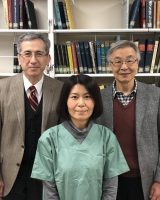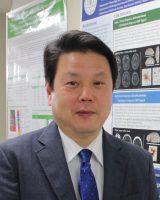Spotlight Researchers
Niigata University actively engages in studies of traditional academic fields as well as cross-disciplinary and cutting-edge research and pursuit of truth that contributes to the development of our society.
Let us introduce some of our prominent researchers.
Aiming to elucidate the mechanism of age-related diseases caused by mitochondrial DNA leaks
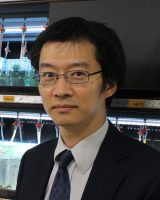
It is known that mitochondrial DNA becomes highly toxic when it leaks into cytoplasm, but only few studies have investigated its pathology and impacts. This study will identify a sensor that detects a mitochondrial DNA leak into cytoplasm and elucidate age-related organ diseases (e.g., dementia, Parkinson's disease, heart disease, liver disease) caused by leaks of mitochondrial DNA into cytoplasm using subjects such as small fish. Also, we will explore possible treatments by processing mitochondrial DNA.
Attempts to shorten breeding period of male-sterile trees as a countermeasure of pollinosis in Cryptomeria japonica
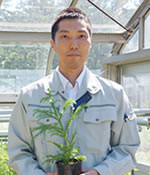
Website
Pollinosis caused by Japanese cedar (Cryptomeria japonica) is a widespread social problem in Japan. As a countermeasure against C. japonica pollinosis, male-sterile trees are expected to play an important role in reducing the amount of pollen dispersed. Associate Professor MORIGUCHI is carrying out research to find a gene mutation that can consistently explain the male-sterile phenotype , and develop a DNA marker that can identify trees with male-sterile genes from populations without family structure. This is expected to greatly shorten the breeding period of male-sterile trees as a countermeasure of pollinosis in C. japonica. In addition, he aims to develop an effective production method of the male-sterile seedlings in C. japonica.
This project was supported by the Ministry of Agriculture, Forestry and Fisheries of Japan (MAFF) between 2016 and 2018 and is supported by the National Agriculture and Food Research Organization (NARO) between 2019 and 2021.
Possibility of far-field Super Planckian radiative heat transfer
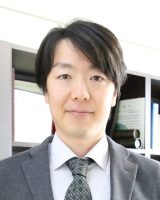
Institute of Science and Technology (Faculty of Engineering)
We focus on far-field coherent thermal radiation transport by metamaterials and try to clarify this photon transport mechanism. If this succeeds, far-field Super Planckian radiative heat transfer exceeding the blackbody radiation limit will be realized, and the radiation mechanism will be controllable. Furthermore, we aim to enhance thermophotovoltaic power generation based on this principle and contribute to the realization of a future smart energy society.
Thermal Science and Control of Spectral Energy Transport, PRESTO, JST
Aiming to establish innovative development and reproduction engineering technology in generating genetically modified marmosets to elucidate the higher brain function of humans
Increasing attention has been paid to studies using genetically modified marmosets for elucidation of the human higher brain function that can overcome mental and neurological diseases. This research will develop a reliable and low-cost method for creating genetically modified marmosets as well as innovative fundamental technology that will help create a reproduction and supply system of wild-type marmosets. Specifically, it includes the development of a stable method for generating mature oocyte and fertilized eggs of marmosets, creation of model animals for brain diseases using fertilized eggs from xenotransplanted ovaries, establishment of naïve ES cells, and the generation of genetically modified animals using blastocyst complementation.
This study is conducted with co-investigator Dr. NAKATSUKASA Ena (Assistant Professor) and Dr. SAKIMURA Kenji (Fellow) at Brain Research Institute, Niigata University.
We aim to unravel the pathogenesis of dementia and develop new therapeutics
The research group led by Professor IKEUCHI aims to elucidate the pathological conditions of dementia and develop treatments. We have established bioresource facility for dementia disorders by collaboration with nation-wide institutes and brain bank network at Brain Research Institute Niigata University. With this effort, we have conducted comprehensive genome research, neuroinformatic analysis, and multi-omics investigation of dementia and neurodegenerative tauopathies.
These researches are supported from the Japan Agency for Medical Research and Development (AMED).
Roles of mitophagy in prevention of hypofunction in whole body
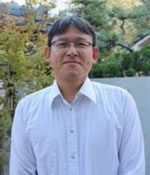
Mitophagy is a process that selectively degrades mitochondria via autophagy. In mammalian cell culture and yeast, it has been revealed that mitophagy contributes to the maintenance or recovery of mitochondrial function by eliminating damaged or excess mitochondria. However, it is currently unclear whether mitophagy plays a role in maintaining and restoring mitochondrial function also at the whole-body level because of the difficulty in observing mitophagy in the animal body and in generating mitophagy-deficient animal models. In this study, we attempt to demonstrate that mitophagy prevents mitochondrial dysfunctioning at the whole-body level during aging.
This research is conducted with support from the Japan Agency for Medical Research and Development (AMED).
Establishing early diagnosis and prediction of onset of severe drug eruption
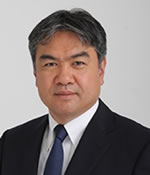
Out of all forms of drug eruptions, toxic epidermal necrosis is known to have a high fatality rate, and hence early diagnosis and appropriate treatment are important. Professor ABE and his colleagues have successfully unveiled the mechanism of epidermal cell death induced by the formyl peptide receptor 1 (FPR1) and ligand (annexin A1) in toxic epidermal necrosis.
They also found that allergy to Helicobacter pylori occurs through the Helicobacter pylori virulence factor carried by exosomes.
They are working to elucidate the mechanism of both cases to apply the results to early diagnosis and onset prediction.
This research is conducted with support from the Japan Agency for Medical Research and Development (AMED).
Aiming at prevention of collision of birds into wind power generation facilities and coexistence with birds

Professor SEKIJIMA's research group is studying the means for birds and wind power generation to coexist by acquiring information on the sea areas used by major seabirds living in Japan through biologging, establishing methods for creating sensitivity maps that make use of the characteristics of each species, and preparing these maps. While the effects of wind power generation to reduce global warming are expected, adverse impacts on local ecosystems caused by bird collisions are also a concern. For this reason, the research group has been proposing bird sensitivity maps with high prediction accuracy incorporating the ecological characteristics of raptors, waterfowls, and seabirds in the aim to visualize areas with high bird collision risks. This research is conducted with support from the Ministry of the Environment.
Developing MRI capable of focusing on "what people want to see"
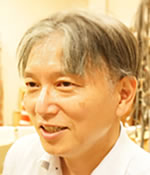
Unlike normal cameras, the present MRI is unable to focus on what people want to see, and contrast agents, which are quite stressful on the human body, must be used when necessary. An experimental physicist, Associate Professor SASAKI has clarified "mysteries and wonders" in various materials science by constructing and improving his own nuclear magnetic resonance (NMR) device, which is the core technology of MRI. He got the idea that applying his skills in the cutting-edge technology would realize MRI that has focusing function without the use of contrast agents. Supported by AMED, he is currently working on this innovative research.
Enhancing Total Resilience Capability focused on the Tokyo Metropolitan Area
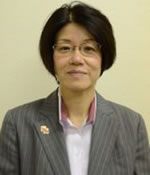
One of the leading earthquake-prone nations in the world, Japan has suffered massive physical, human, and economic damages to date. Vulnerability to disasters is a major issue in the Tokyo metropolitan area in particular, given that this is where population is concentrated and that it is the center of socio-economic activities. Thus, it has become more important than ever to assess disaster risks in detail and implement measures to prepare for disasters, to maintain capital functions when disasters strike. This research has constructed DEKATSU, 'the Council for Utilizing Public and Private Sectors Data' in order to collect and prepare data for contributing to the improvement of comprehensive resilience centering around the Tokyo metropolitan area, implement and verify "the construction of a collaborative structure" and "consideration of rules on provision and mutual use" related to data usage, and review the measures for rolling out "data utilization frameworks necessary for disaster resilience" to society. This research is conducted with support from the National Research Institute for Earth Science and Disaster Resilience (NIED)
Identification of root-to-shoot long-distance signaling peptides and applying them to plants to control nutrient allocation and stress tolerance at the whole-plant level
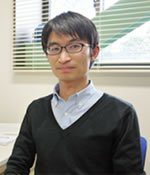
The development of technologies for crops to adapt to environmental stresses such as climate change is indispensable for solving food problems around the world including Japan. To this end, the development of next-generation fundamental technologies for designing plants that grow stably and adapt to environmental changes in the field from the molecular level is awaited. Assistant Professor OKAMOTO is carrying out work to identify root-to-shoot signaling molecules using crops such as soybeans. In addition to understanding the long-distance signaling mechanism, he also aims to develop basic technique to control crop growth and nutrient distribution at the whole-plant level. This research is conducted with support from the Japan Science and Technology Agency (JST).
+PRESTO, Strategic Basic Research Programs, JST
International collaborative research on AC superconductivity - Aiming to develop extremely low AC loss technology-
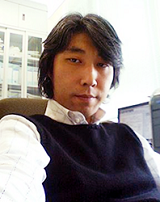
The superconducting technology is an ultimate energy-saving technology that can be one of breakthroughs to solve global energy problems. It is well known that the superconductor has zero resistivity, so that no electrical loss in the DC condition. However in the AC condition, the superconductor generates losses called 'AC losses'. To realize innovations in the electric energy infrastructure by applying the superconducting technology, the development of extremely low AC loss technology is necessary. Professor FUKUI and his colleges have advanced many researches related to AC superconductivity, particularly, they have significant research achievements on the evaluation methods of the AC loss and its reduction methods. In this project, Professor FUKUI's research group (Niigata univ., Shibaura Institute of Tech., National Institute for Materials Science, Ashikaga Univ.) is developing the international collaborative research on AC superconductivity with research institutions in Germany (Karlsruhe Institute of Tech., Technical Univ. Darmstadt and Leibniz Institute for Solid State and Material Research Dresden), France (Univ. of Lorraine) and the Netherlands (Univ. of Amsterdam). Through this International collaborative research, the wide-range researches concerning basics and applications of AC superconductivity are done aiming to develop extremely low AC loss technology. This project is conducted with support from the Japan Society for the Promotion of Science (JSPS).
Aiming to develop next generation regenerative medicine by elucidating liver regeneration mechanism
Professor TERAI developed the world's first autologous bone marrow cell infusion (ABMi) therapy in 2003 and has been verifying its effects for improving hepatic fibrosis and subsequent liver regeneration through clinical studies. Aiming at clinical applications, Professor TERAI and his group have been conducting research and development aimed at improving hepatic fibrosis in cirrhosis by bone marrow cells (mesenchymal stem cells, macrophages) and clarifying the mechanism by which liver regeneration is induced, and developing next-generation regenerative medicine. They found that mesechymal stem cell work as a "conducting cell" to change macrophage into M2 phenotype from M1 and improved liver fibrosis and liver regeneration. In this system mesenchymal stem cell injection activate immunomodulation to improve liver cirrhosis. (Stem Cells Transl Med. 2019 Mar; 8(3):271-284. Inflamm Regen. 2019 Sep 9;39:18.)
This research is conducted with support from the Japan Agency for Medical Research and Development (AMED).
In clinical field Prof. TERAI stated Japan first clinical trial "Allogenic adipose tissue derived MSC therapy for liver cirrhosis" with Rhoto company from 2017.
Development of novel tumor-targeting peptides for conquering intractable cancer
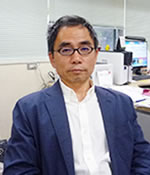
Professor KONDO and his colleagues possess a technology for developing tumor-homing peptides which exhibits highly selective penetration to target tumor cells of certain lineage resulting in their accumulation in tumor tissues. It is a novel non-inavasive bio-tool to fight cancer (DDS *1). By developing a peptide drug conjugate (PDC) using their pancreatic cancer homing peptide as an antitumor DDS tool, they aim to develop effective medical care to eradicate residual/recurrent lesions and/or remote metastases as well as primary tumor in patients with pancreatic cancer, a representative intractable cancer. This research is conducted with support from the Japan Agency for Medical Research and Development (AMED).
*1 DDS: Drug Delivery System
Mechanisms and physiology of lipid countertransport systems
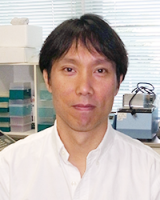
Intracellular transport of lipids is tightly controlled to support a variety of fundamental cellular functions. As the connection between malfunctions of the intracellular lipid transport regulations and various human diseases becomes progressively evident, a comprehensive understanding of the role of such regulations is increasingly important. The primary goal of the current study is to identify novel lipid countertransport systems in cells, and investigate them at molecular, cellular and organism levels. This study is supported by the Japan Agency for Medical Research and Development (AMED).
Understanding brain function from protein behavior
One of the most dense and complicated tissues, brain tissue contains thousands of proteins that play roles in various brain functions. In this study, Professor MIKUNI aims to develop a method that allows for the labeling of any endogenous protein with any tag within single brain cells via genome editing. Using this method, the professor and his colleagues try to observe the localization and dynamics of endogenous proteins in complex brain tissues with high specificity, sensitivity, resolution and contrast. This method will provide a new platform to comprehensive understanding of brain functions at the cellular and molecular level. This research is conducted with support from the Japan Science and Technology Agency (JST).
RESEARCH AREA: Innovative technology platforms for integrated single cell analysis, PRESTO, JST
Evaluating the effectiveness of human papillomavirus (HPV) vaccination

Most of the cervical carcinomas are caused by human papillomavirus (HPV) infection. In Japan, the peak incidence of cervical carcinoma occurs in young women in their 30s. Professor ENOMOTO and his colleagues have been conducting joint research with Osaka University and Yokohama City University since 2012 to verify the effectiveness of the HPV vaccination to reduce HPV infection rate and reduce the prevalence of malignant and premalignant lesion of uterine cervix among Japanese women. The interim analysis revealed that the bivalent HPV vaccine is highly effective against HPV16 and 18 in women sexually naive at vaccination. Furthermore, significant cross-protection against HPV31, 45, and 52 was demonstrated.
This research has been conducted with continuous support from the Japan Agency for Medical Research and Development (AMED) since 2012.
Clarifying the epidemiology and transmission patterns of influenza and respiratory viruses in Asia

Myanmar is an important area in Asia because it is situated adjacent to densely populated countries such as China and India where influenza viruses with new antigenicity is likely to emerge. Through her past studies, in Myanmar influenza viruses with new antigenicity could be found a half year earlier than in Japan. Thus Myanmar is a crucial location for influenza vaccine strain selections. Professor SAITO established a research center for Infectious diseases at the National Health Laboratory (NHL) in Yangon with the support of the Japan Agency for Medical Research and Development (AMED) under the strong partnership with the Ministry of Health and Sports of Myanmar. Professor SAITO and Myanmar researchers aim to investigate the epidemiology of respiratory virus infections in Myanmar, and clarify transmission patterns of influenza and respiratory viruses in Asia. Her long term goal is to the human resource development, who can contribute to control of infectious diseases. This research is conducted with support from the Japan Agency for Medical Research and Development (AMED).
+ Approach to Respiratory Infection Control in Myanmar, J-GRID from AMED
+ Japan Initiative for Global Research Network on Infectious Diseases (J-GRID), AMED

